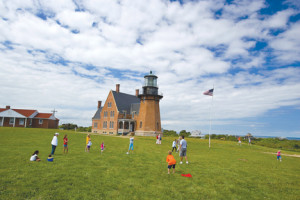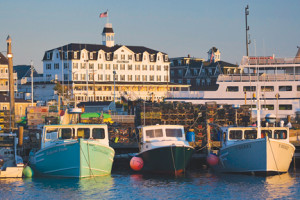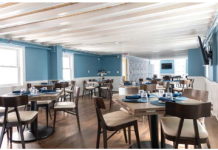By Linda McK. Stewart
BLOCK ISLAND, R.I. – A turnip-shaped chunk of land, 7 miles wide, 10 miles long, lying about 13 miles off the coast of Rhode Island.
Nine months a year the Block nestles safely in the loving hands of its 1,000 year-round residents. But come summer, those residents suffer the invasion of thousands of mainlanders. Vacation-bound – in flip-flops and shorts – they pour off the ferries from New London, Newport, Long Island. They come laden with duffles, backpacks, bikes and surfboards. From the bigger ferries roll carloads of families, kids and dogs dangling eagerly from the windows.
June through September they arrive in their biblical hordes. No sooner ashore than their SUVs, BMWs, their 85-speed bicycles and their custom-designed strollers are jamming the traffic on Water Street. Star’s Department Store is awash with ponytailed, high school cheerleaders, pawing happily through stacks of the latest T-shirts. At the Old Harbor View, where the Lobster Roll Special is legendary, lines form all the way out to the road. At Ben & Jerry’s, (one of only two island franchises, the other, a miniature Starbucks) a week’s supply of Chunky Monkey is gone in one afternoon.
Any casual observer watching this summer influx could easily assume that the invaders have taken over the entire island, re-shaping it in their own image. But such an assumption would be wrong. Blessedly wrong.
Unlike other island resorts, Block Island remains firmly in the hands of its landowners, a unique band of dyed-in-the-wool conservationists. It’s estimated that 47 percent of the island’s 7,040 acreage is held in some sort of conservancy. Were it not for this sturdy band of hands-on activists, Block Island would long since have been swept under by the 21st century’s onrushing tide of tourism.
Because of its surrounding shoals, whaling never took hold on Block Island as it did on Nantucket and elsewhere. Farming was long the island’s economic mainstay. No more. Yet the meadows, crisscrossed by stonewalls, look much as they did a century ago. Shaggy cows stand belly deep in the Irish-green fields. Clouds of butterflies work the stands of milkweed. Black-eyed Susans, Queen Anne’s Lace, goldenrod and white yarrow thrive in happy profusion. The purple clover is abuzz with honeybees. The fields roll down to the sea’s edge.
Nowhere in sight is the slightest hint of commercialism. It’s a proud island boast that there is not a single neon sign, not a single traffic light on the whole island. No billboards. Every roadside sign must pass committee inspection. Strict zoning laws have imposed a pleasing harmony on the island’s 1,600 private homes, most of them of shingle construction. They nestle in the folds of the hills or along the quiet two-lane roads with nary a McMansion among them. Driveways for the most part are unpaved, sandy lanes. Grandiose does not play well here.
From the North Lighthouse, built in 1867, to the Southeast Lighthouse, there are dozens of white sand beaches, free and open to all. But don’t look for a beach club. There is none – and no golf club, either.

Not long after the Civil War, Block Island enjoyed a small boomlet of tourism, which produced a dozen or so rambling, Victorian-style hotels, complete with mansard roofs, elegant turrets and wraparound porches. Of these, a handful still stand: the Surf Hotel, smack on the beach in the center of town, the National Hotel with its flag-bedecked frontage, the Narragansett Inn on Great Salt, Pond, most of them booked well in advance for summer weddings.
Biking is a favorite form of transport but bikes must compete with mopeds which, if many islanders had their say, would be forbidden. Still moped enthusiasts provide the island’s one small but efficient medical clinic with a steady stream of skinned knees and scraped elbows.
For my money, the best way to explore the Block is in the company of Tim McCave of Rustic Farms Rides. Every day, weather permitting, he leads morning and afternoon rides on beaches or along woodland trails.
Is there anything more satisfying than cantering along a beach, splashing through shallow water with the spray flying up to catch the early morning sunlight?
Kayaking is almost as popular as surfing and with 365 fresh water ponds on the island, it’s not hard to find a convenient put-in spot.
Life on Block Island unfolds to gentle, laid-back tempos. No black-tie fundraisers. No fashion shoots on the ferry dock. No hotshot political rallies. Block Island (to mangle a metaphor) marches to its own drummer…as so well exemplified in a recent town meeting: Mr. X, responsible for orderly behavior at the town dump (a favorite meeting place for all householders) raised a protest. He pointed out that Mrs. Y, the Clam Warden lady, wore a uniform with an official nametag on it. If the Clam Warden was entitled to a uniform, why was he, as Warden of the Dump, not entitled to a uniform as well? A brief recess was called. In short order, the meeting reconvened. A decision had been taken: Quite right. Mr. X, as Warden of the Dump was indeed entitled to a uniform. However, the decree went on, it was up to Mr. X to procure his own uniform. From the dump. Meeting adjourned.
IF YOU GO: For additional information see www.BlockIslandGuide.com.















